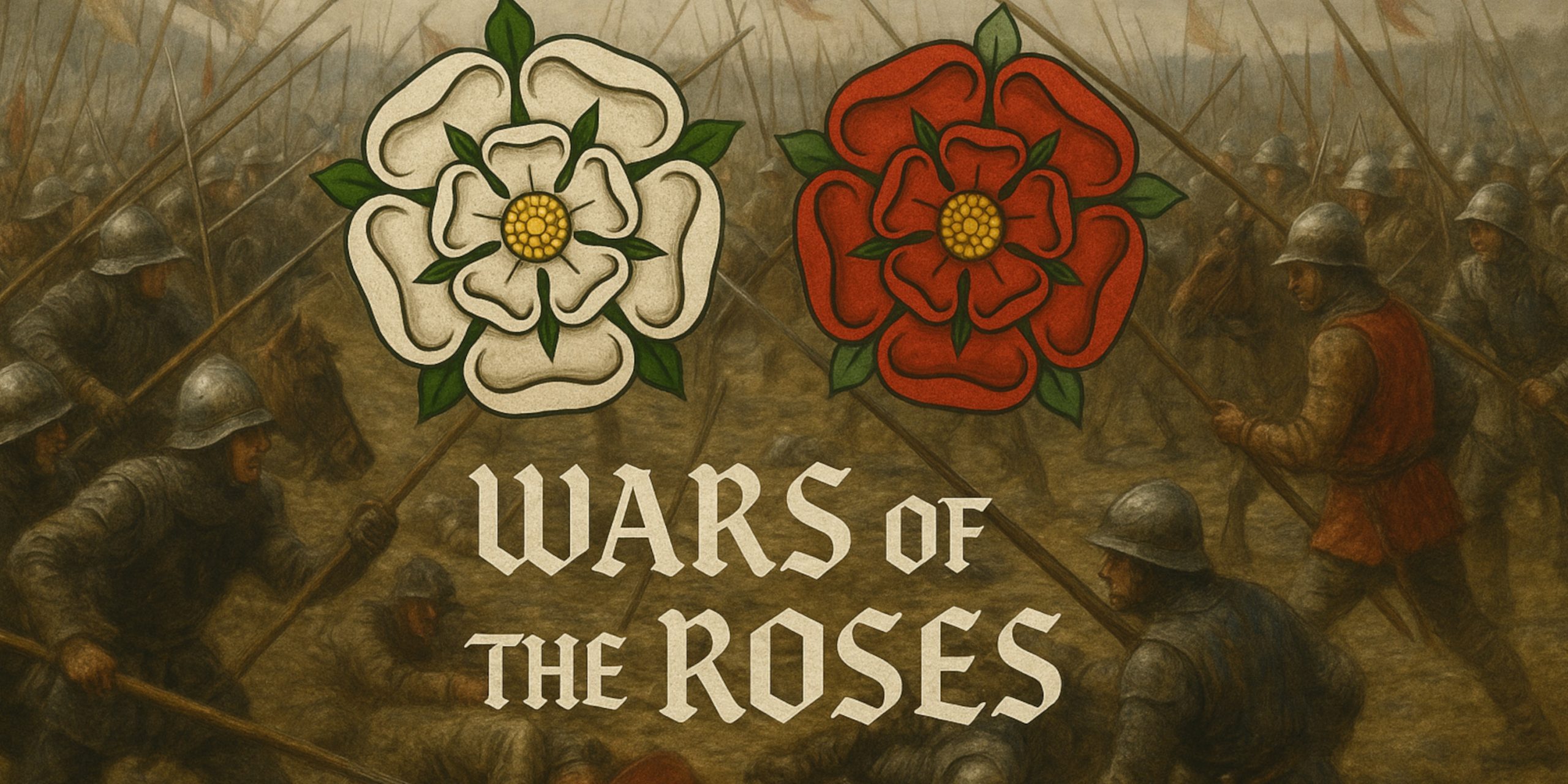
The Wars of the Roses were a violent contest for the English crown fought between the rival houses of Lancaster and York from 1455 to 1487. Over the course of three decades, alliances fractured, kings were deposed, and noble houses rose and fell. The conflict shaped not just English monarchy but the entire structure of late medieval politics. Below is a full list of major battles in chronological order, detailing each clash’s context, commanders, weapons, and long-term impact.
First Battle of St Albans (22 May 1455)
Commanders:
Richard, Duke of York and Earl of Warwick (Yorkist) vs Edmund Beaufort, Duke of Somerset (Lancastrian)
Troop Estimates:
Yorkists: ~3,000
Lancastrians: ~2,000
Weapons Used:
Longbows, swords, poleaxes, early handguns
Outcome:
Yorkist victory
Legacy:
The first true battle of the wars. Somerset was killed, and Henry VI was taken captive. It began the open rivalry between the two houses.
Battle of Blore Heath (23 September 1459)
Commanders:
Lord Salisbury (Yorkist) vs Lord Audley (Lancastrian)
Troop Estimates:
Yorkists: ~6,000
Lancastrians: ~10,000
Weapons Used:
Longbows, billhooks, swords
Outcome:
Yorkist victory
Legacy:
Marked the start of renewed hostilities after a fragile peace. Lord Audley was killed. Salisbury’s victory energised the Yorkist cause.
Battle of Ludford Bridge (12 October 1459)
Commanders:
Yorkist leaders vs King Henry VI and Lancastrians
Troop Estimates:
Yorkists: ~12,000
Lancastrians: ~20,000
Weapons Used:
Largely a bloodless rout
Outcome:
Lancastrian psychological victory
Legacy:
Yorkist forces fled without fighting. Many leaders, including the Duke of York, fled to Calais. It exposed internal divisions within the Yorkist ranks.
Battle of Northampton (10 July 1460)
Commanders:
Warwick and Edward of March (Yorkist) vs King Henry VI (Lancastrian)
Troop Estimates:
Yorkists: ~12,000
Lancastrians: ~10,000
Weapons Used:
Swords, pikes, longbows
Outcome:
Yorkist victory
Legacy:
Yorkists captured Henry VI and solidified their hold on government. The battle demonstrated the fragility of Lancastrian command.
Battle of Wakefield (30 December 1460)
Commanders:
Richard, Duke of York (Yorkist) vs Queen Margaret and Duke of Somerset (Lancastrian)
Troop Estimates:
Yorkists: ~5,000
Lancastrians: ~15,000
Weapons Used:
Swords, pikes, longbows, cavalry
Outcome:
Lancastrian victory
Legacy:
Richard of York and his son Edmund were killed. Their heads were displayed on pikes at York. The Yorkist cause passed to Edward, Earl of March.
Battle of Mortimer’s Cross (2 February 1461)
Commanders:
Edward of March (Yorkist) vs Owen Tudor and Jasper Tudor (Lancastrian)
Troop Estimates:
Yorkists: ~5,000
Lancastrians: ~6,000
Weapons Used:
Billhooks, longbows, polearms
Outcome:
Yorkist victory
Legacy:
Secured Wales for Edward. Owen Tudor was captured and executed. A meteorological phenomenon (sun dogs) was seen as divine approval for Edward’s cause.
Second Battle of St Albans (17 February 1461)
Commanders:
Queen Margaret (Lancastrian) vs Earl of Warwick (Yorkist)
Troop Estimates:
Lancastrians: ~10,000
Yorkists: ~9,000
Weapons Used:
Longbows, poleaxes, cavalry, swords
Outcome:
Lancastrian victory
Legacy:
Henry VI was rescued from Yorkist control, but the Lancastrians again failed to march on London. Their indecision proved costly.
Battle of Ferrybridge & Towton (28–29 March 1461)
Commanders:
Edward IV and Warwick (Yorkist) vs Henry VI and Duke of Somerset (Lancastrian)
Troop Estimates:
Towton: ~50,000 combined
Ferrybridge: ~8,000 combined
Weapons Used:
Longbows, billhooks, swords, axes, cavalry
Outcome:
Decisive Yorkist victory at Towton
Legacy:
The bloodiest battle on English soil. Over 20,000 killed. Edward IV secured the throne. The scale and savagery of Towton became symbolic of the entire war.
Battle of Hedgeley Moor (25 April 1464)
Commanders:
John Neville (Yorkist) vs Sir Ralph Percy (Lancastrian)
Troop Estimates:
Small forces; exact numbers unknown
Weapons Used:
Swords, longbows, polearms
Outcome:
Yorkist victory
Legacy:
Percy was killed. Helped dismantle remaining Lancastrian strongholds in the north.
Battle of Hexham (15 May 1464)
Commanders:
John Neville (Yorkist) vs Henry Beaufort, Duke of Somerset (Lancastrian)
Troop Estimates:
Yorkists: ~10,000
Lancastrians: ~6,000
Weapons Used:
Billhooks, bows, swords
Outcome:
Yorkist victory
Legacy:
The final large-scale northern Lancastrian resistance ended. Somerset was captured and executed. Henry VI was forced into hiding.
Battle of Edgecote Moor (26 July 1469)
Commanders:
Robin of Redesdale (Lancastrian rebel) vs William Herbert (Yorkist)
Troop Estimates:
Yorkists: ~6,000
Rebels: ~5,000
Weapons Used:
Polearms, longbows, swords
Outcome:
Rebel victory
Legacy:
Warwick’s indirect hand in the rebellion became clear. Edward IV was briefly taken into custody. Internal Yorkist rivalries deepened.
Battle of Losecoat Field (12 March 1470)
Commanders:
Edward IV (Yorkist) vs Sir Robert Welles (Lancastrian rebel)
Troop Estimates:
Yorkists: ~15,000
Lancastrians: ~10,000
Weapons Used:
Billhooks, pikes, longbows
Outcome:
Yorkist victory
Legacy:
Welles confessed Warwick’s involvement. His defeat forced Warwick to flee to France and ally with Margaret of Anjou.
Battle of Barnet (14 April 1471)
Commanders:
Edward IV (Yorkist) vs Earl of Warwick (Lancastrian)
Troop Estimates:
Each side ~15,000
Weapons Used:
Poleaxes, longbows, cavalry, swords
Outcome:
Yorkist victory
Legacy:
Warwick was killed. Mist and confusion caused friendly fire among Lancastrians. It marked the end of Warwick’s kingmaker role.
Battle of Tewkesbury (4 May 1471)
Commanders:
Edward IV (Yorkist) vs Queen Margaret and Prince Edward (Lancastrian)
Troop Estimates:
Yorkists: ~10,000
Lancastrians: ~6,000
Weapons Used:
Longbows, swords, cavalry, pikes
Outcome:
Yorkist victory
Legacy:
Prince Edward was killed. Margaret was captured. The Lancastrian heir was gone, and Henry VI was murdered soon after. The Lancastrian cause collapsed.
Battle of Bosworth Field (22 August 1485)
Commanders:
Henry Tudor (Lancastrian) vs Richard III (Yorkist)
Troop Estimates:
Henry: ~5,000
Richard: ~12,000 (with questionable loyalty from nobles)
Weapons Used:
Cannon, longbows, poleaxes, cavalry
Outcome:
Tudor victory
Legacy:
Richard III was killed, reportedly in hand-to-hand combat. Henry Tudor became Henry VII. It marked the formal end of Plantagenet rule and the beginning of the Tudor era.
Battle of Stoke Field (16 June 1487)
Commanders:
Henry VII (Tudor) vs John de la Pole and Martin Schwartz (Yorkist)
Troop Estimates:
Tudors: ~15,000
Yorkists: ~8,000
Weapons Used:
Billhooks, pikes, longbows, handguns
Outcome:
Decisive Tudor victory
Legacy:
The last battle of the Wars of the Roses. Ended Yorkist attempts to reclaim the throne through pretenders. Henry VII’s regime was now secure.
Watch the documentary:



